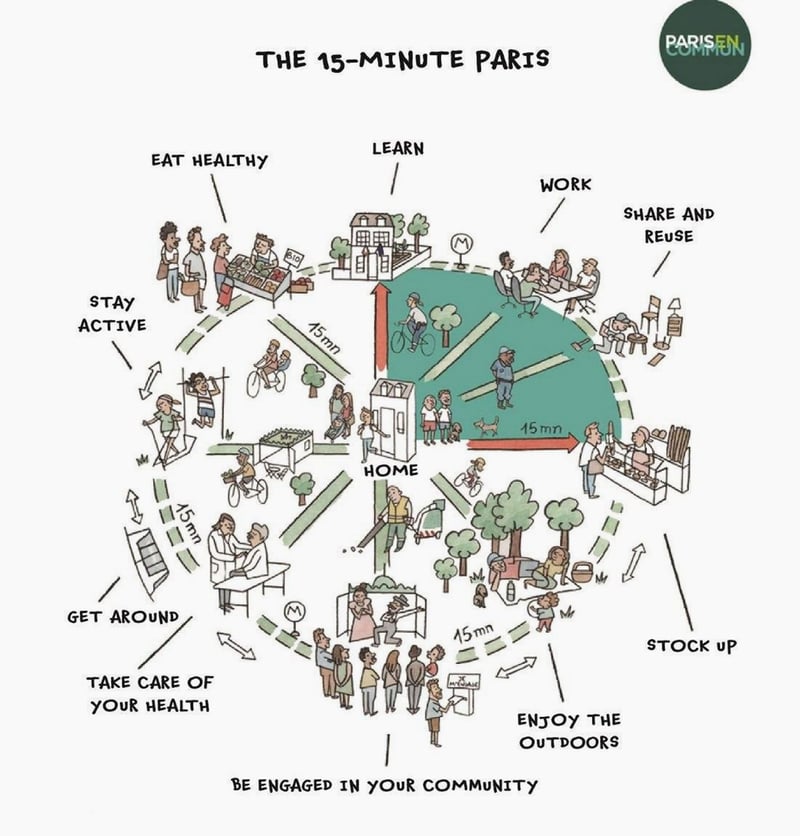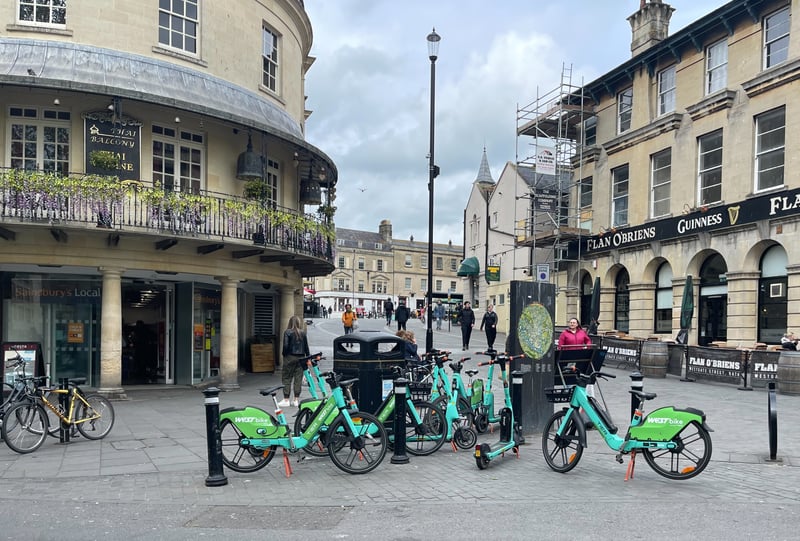|
|
|
|
|
|
|
Dear DNA friends,
I hope you’re all doing well. Jump ahead for Design Things to Do, including Design Miami.LA and sonically charged ceramics at Adam Silverman’s Common Ground artwork for a less divided world. Before that, a thought on cities.
I am writing to you from Old Europe — not from one of the current hotspots (Venice Biennale! Milan Furniture Fair! Paris on the eve of the Olympics!). Rather, I’m in Bath, England (spring tulips, above), spending time with my mom as she recovers from an injury.
Bath is a small country town, which you may know from Jane Austen novels; or for its ancient spa waters, enjoyed by Celts, Romans, Georgians, and Bathonians today. Mom lives in the town center and has much to say about the changes afoot. Her biggest beef is the closure of many roads for most cars (purportedly for security reasons), which brings me to The 15-Minute City: A Solution to Saving Our Time and Our Planet.
 Infographic from The 15-Minute City. Image by Nicolas Bascop & Michael. Infographic from The 15-Minute City. Image by Nicolas Bascop & Michael.
This is a new book, due out in early May, by Carlos Moreno, the Columbian-born, Paris-based roboticist, systems analyst, and urban thinker who argues that humanity needs to override twentieth-century, sprawling, car-based cities with dense, mixed-use, mixed-income communities in which residents can get everything they need within a 15-minute walk, bike or transit ride, or 30 minutes in more spread-out places.
The 15-Minute City has echoes of New Urbanism. It is a unifying theory of city-making that encompasses all the efforts since Jane Jacobs fought the construction of the Lower Manhattan Expressway to mend the city fabric riven by urban highways and zoning of work, home, and leisure. Such efforts include preserving existing fabric, interventions like bike lanes, pedestrianized streets, and pocket parks, plus community engagement and denser, mass-transit-based living. To these, Moreno has added the urgent imperatives of climate change and the pandemic, which he says woke up the world to new priorities — the desire for fresh air, open space, and social connection — while crushing the daily home-to-work paradigm.
The book explores cities that have embraced the 15-minute philosophy, most visibly Paris, under the forceful leadership of Mayor Anne Hidalgo, as well as Portland, Oregon; Busan, South Korea; Sousse, Tunisia, and several other municipalities. Even in the quintessential car-based region of Los Angeles, his ideas have gained traction and you’ll often hear the 15-minute city invoked in connection with traffic calming and densification schemes. Moreno believes life in these places will be less “masculine,” less speed-obsessed (unlike my mother, who loves driving fast), less polluted, and filled with relaxed people living in “happy proximity.”
Moreno seems to subscribe to the “great man theory” of what ails cities: he ascribes runaway suburbia more to the malign influence of architect Le Corbusier and the American PR Edward Bernays than to its appeal to millions of people burned out on early industrial city life. So a defense of non-proximity has arisen. The British government has decried the 15-minute city concept; a critic wrote that car-free streets would impose an “unprecedented level of control over public space and the daily lives of residents.”
And this is what gets my mom worked up. Leaving aside her speed-freakery, she asks what happens to the seniors who need to get ferried to the hospital, the delivery people getting to the stores, the families herding young children, the tourists with heavy suitcases, and the care workers and teachers who simply cannot afford to live within the neat 15-minute circle. After all, many a pleasant 15-minute city, such as Paris, has lost affordable homes to Airbnb, global investors, or resistance to affordable residential development.
If it were possible to thread this needle, however, 15-minute city living could be lovely. Bath, with its now less trafficked streets, it certainly a pleasant place to walk in. Sorry, mom!
 Most cars are unable to enter this city center street in Bath, after 10:00 AM. Photo by Frances Anderton. Most cars are unable to enter this city center street in Bath, after 10:00 AM. Photo by Frances Anderton.
For anyone wanting to hear from Moreno directly, he will be sharing his ideas in Los Angeles next Tuesday, May 7th. Unfortunately, it won’t be in a widely accessible space. He will join a line-up of speakers discussing Technology Powering Urban Innovation at the elite Milken Institute Global Conference, aka Davos West. He is one of several hundred speakers who will take on the 2024 topic of "Shaping a Shared Future."
|
|
|
|
|
|
|
|
|
|
|
|
|
|
|
|
|
|
|
|
|
|
|
|
|
|
|
|